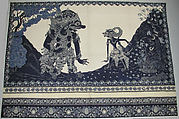Wall Hanging
Not on view
Perhaps the most familiar Javanese art form in the West is shadow puppetry (wayang kulit), named for the stiff leather (kulit) used to make the flat, jointed puppets. Shadow-puppet plays are performed by a single puppeteer (dalang), who sits behind a white cloth screen, backlit by the flickering flame of an oil lamp, and holds the puppets up to the screen so that only their shadowy silhouettes are visible to the audience on the other side. Although contemporary Javanese are Muslims, most of the repertoire of wayang kulit is drawn from the great epics of Hinduism, the island’s dominant religion prior to Islam, especially from the Mahabharata and the Ramayana .
Dyed with deep blues on a pure white background to evoke the effect of a shadow-puppet performance, this textile portrays a scene from the Ramayana and was probably intended as a decorative wall hanging. At right is the monkey warrior Hanuman (known as Anoman in Javanese), who aids the epic’s hero, Rama, in rescuing his kidnapped wife. Anoman, his long tail curling up his back, confronts a giant being named Prahasto. The figures appear against an elaborate background of mountains, trees, and European-influenced images of deer and a snake, completely unlike the plain white screen used for (wayang kulit. This background was likely added to make the textile more appealing to a Western buyer (imagery from Javanese shadow puppetry was popular among Dutch visitors and colonial officials seeking a memento of their time in Indonesia). Produced with cloth manufactured in the Netherlands, decorated in Solo (now the Javanese city of Surakarta), and brought back to Holland, this textile exemplifies the roles that artworks, spices, and other commodities from Indonesia have played in the global economy for centuries.
Due to rights restrictions, this image cannot be enlarged, viewed at full screen, or downloaded.
This artwork is meant to be viewed from right to left. Scroll left to view more.






